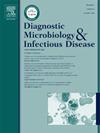“What am I?” microbiology of culture-positive, biofire® blood culture identification 2 panel-negative bloodstream infections
IF 2.1
4区 医学
Q3 INFECTIOUS DISEASES
Diagnostic microbiology and infectious disease
Pub Date : 2025-04-11
DOI:10.1016/j.diagmicrobio.2025.116846
引用次数: 0
Abstract
Background
The BioFire® blood culture identification 2 panel (BCID2) detects 33 of the most common bloodstream infection (BSI) pathogens, yet it can fail to detect the causal agent of sepsis in up to 13 % of cases, mostly due to infections caused by off-panel target microorganisms. A better understanding of the microbiology of culture-positive, BCID2-negative BSI is needed.
Methods
Single-center, retrospective study of microbiology and outcomes in 275 cases of BCID2-negative BSI between 2022 and 2024.
Results
A total of 257 adult patients with 275 cases of culture-positive, BCID2-negative BSI were analyzed. Viable organisms were identified in 95.2 % of the cases. False negative results (i.e., in-BCID2 panel target microorganism) occurred at 3.3 % and corresponded mostly to Candida spp. (67 %). Although microorganisms considered of low clinical significance accounted for more than a third of the cases, off-BCID2 panel, clinically relevant microorganisms identified by culture included Bacteroides spp. (other than B. fragilis; 12 %), Clostridium spp. (5.8 %), Candida spp. (4.4 %), Achromobacter xylosoxidans, Pasteurella multocida, Trichosporon asahii, Fusarium spp., Rhodococcus equi, Capnocytophaga spp., and Burkholderia cepacia, among others. Only 116 (42 %) were on appropriate antibiotic therapy at the time of BCID2 result. 30-day mortality was 24 % in the entire cohort, but as high as 33 %, 44 %, and 42 % for Bacteroides spp., Clostridium spp. and Candida BSI, respectively.
Conclusions
These results highlight the limitations of the BCID2 panel (e.g., need for inclusion of pan-Bacteroides and Clostridium spp., and optimization of sensitivity for Candida spp.); and provide useful insights on the most common causes of BCID2-negative BSI.
“我是什么?”微生物学培养阳性,biofire®血液培养鉴定2面板阴性血流感染
BioFire®血培养鉴定面板(bid2)可检测33种最常见的血流感染(BSI)病原体,但在高达13%的病例中,它可能无法检测到败血症的致病因子,主要是由于面板外目标微生物引起的感染。需要更好地了解培养阳性、bid2阴性BSI的微生物学。方法对2022 - 2024年间275例bcd2阴性BSI患者进行单中心、回顾性的微生物学及转归研究。结果共分析257例成人BSI患者,其中培养阳性、bcd2阴性275例。95.2%的病例检出活菌。假阴性结果(即in- bccid2靶微生物)发生率为3.3%,主要与假丝酵母菌相关(67%)。尽管被认为具有低临床意义的微生物占病例的三分之一以上,off- bid2小组,通过培养鉴定出的临床相关微生物包括拟杆菌(Bacteroides spp.)(除脆弱杆菌;12%),梭状芽孢杆菌(5.8%),念珠菌(4.4%),木氧化无色杆菌,多杀巴氏杆菌,ashitrichosporon,镰刀菌,马红球菌,嗜碳细胞菌和洋葱伯克氏菌等。只有116例(42%)在bccid2结果时接受了适当的抗生素治疗。在整个队列中,30天死亡率为24%,但拟杆菌、梭状芽孢杆菌和假丝酵母分别高达33%、44%和42%。结论这些结果突出了bccid2面板的局限性(例如,需要包含泛拟杆菌和梭状芽孢杆菌,以及对念珠菌的敏感性优化);并就bid2阴性BSI的最常见原因提供有用的见解。
本文章由计算机程序翻译,如有差异,请以英文原文为准。
求助全文
约1分钟内获得全文
求助全文
来源期刊
CiteScore
5.30
自引率
3.40%
发文量
149
审稿时长
56 days
期刊介绍:
Diagnostic Microbiology and Infectious Disease keeps you informed of the latest developments in clinical microbiology and the diagnosis and treatment of infectious diseases. Packed with rigorously peer-reviewed articles and studies in bacteriology, immunology, immunoserology, infectious diseases, mycology, parasitology, and virology, the journal examines new procedures, unusual cases, controversial issues, and important new literature. Diagnostic Microbiology and Infectious Disease distinguished independent editorial board, consisting of experts from many medical specialties, ensures you extensive and authoritative coverage.

 求助内容:
求助内容: 应助结果提醒方式:
应助结果提醒方式:


